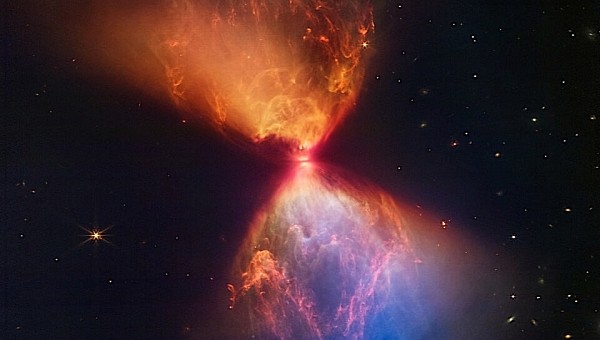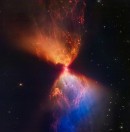It’s been only a few short months since the James Webb Space Telescope became operational, and we’ve already been treated with stunning images of the cosmos, including more recently the Cartwheel and Phantom galaxies, the Pillars of Creation, or the effects of the DART impact in the far reaches of the solar system. And wonders keep coming our way.
The latest is the one we’re here to talk about now, the hourglass-shaped explosion of light and color Webb was able to capture as it stares into the vacuum of the Universe and its past.
Such shapes we’ve seen before, but there’s something in there that has really caught the eye of the telescope’s operators. That would be “the once-hidden features of the protostar, […] providing insight into the formation of a new star."
Webb used its Near Infrared Camera (NIRCam) to snap the image, as the clouds in this Taurus star-forming region are only visible in infrared light. And to be honest, if it weren’t for the European Space Agency (ESA) to explain what we’re seeing, an hourglass of light is all we would have seen.
ESA says the star, called L1527, is located 430 light-years away from us and is hidden from view “within the ‘neck’ of this hourglass shape.” Its presence there can be deduced however thanks to the edge-on protoplanetary disc (the dark line across the middle of the neck) and the light leaking above and below the disc.
The colors we’re seeing “are due to layers of dust between Webb and the clouds,” with blue showing areas where the dust is thinnest and orange thickest.
ESA says the protostar is just 100,000 years old, making it a baby by star standards. Just like any baby, it’s causing a hell of a commotion in its region as it tries to gather mass and grow from its current size, which is about 40 percent that of our own Sun, but there's no nuclear hydrogen fusion yet.
Webb has a lot more such cosmic brats it plans to check up on in the coming months, so keep close if interested in such stuff.
Such shapes we’ve seen before, but there’s something in there that has really caught the eye of the telescope’s operators. That would be “the once-hidden features of the protostar, […] providing insight into the formation of a new star."
Webb used its Near Infrared Camera (NIRCam) to snap the image, as the clouds in this Taurus star-forming region are only visible in infrared light. And to be honest, if it weren’t for the European Space Agency (ESA) to explain what we’re seeing, an hourglass of light is all we would have seen.
ESA says the star, called L1527, is located 430 light-years away from us and is hidden from view “within the ‘neck’ of this hourglass shape.” Its presence there can be deduced however thanks to the edge-on protoplanetary disc (the dark line across the middle of the neck) and the light leaking above and below the disc.
The colors we’re seeing “are due to layers of dust between Webb and the clouds,” with blue showing areas where the dust is thinnest and orange thickest.
ESA says the protostar is just 100,000 years old, making it a baby by star standards. Just like any baby, it’s causing a hell of a commotion in its region as it tries to gather mass and grow from its current size, which is about 40 percent that of our own Sun, but there's no nuclear hydrogen fusion yet.
Webb has a lot more such cosmic brats it plans to check up on in the coming months, so keep close if interested in such stuff.








